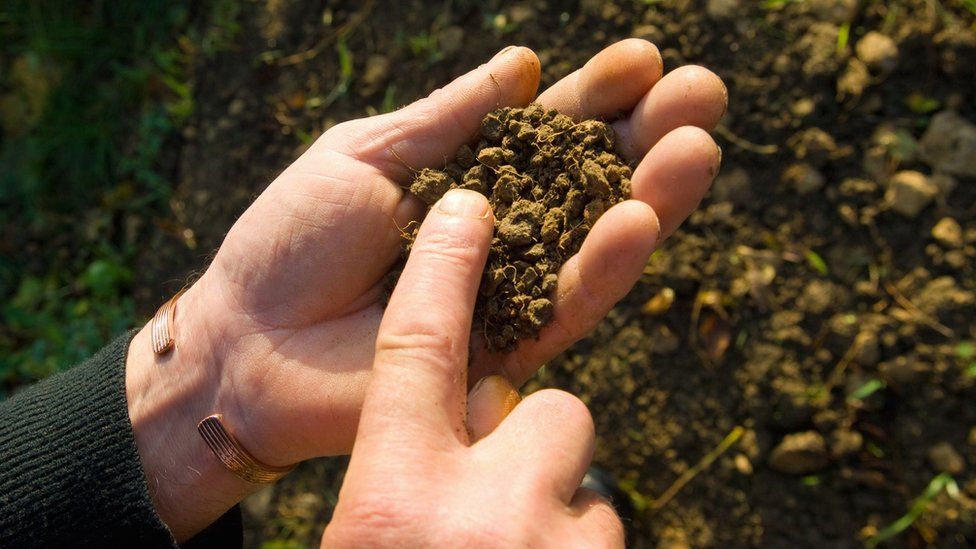ARTICLE AD BOX
 Image source, Getty Images
Image source, Getty Images
Farm soil can be degraded by a number of factors, such as not rotating crops and the use of pesticides
By Jane Wakefield
Technology reporter
Farmers used to test the quality of their soil by burying a pair of underpants in the ground and seeing how quickly they rotted.
The idea being that the more healthy micro-organisms there are in the ground, such as bacteria and fungi, the faster the fabric would be eaten away.
Bury the pants now and they may well be dug up the following year in pristine condition.
That's because, according to experts, more than half of the world's agricultural soil is already degraded.
In India, soil degradation is one of the factors, alongside debt, that is said to have led to the shocking statistic of nearly 30 people in the farming sector taking their own lives, on average, every day.
To try to improve matters, a popular Indian guru called Sadhguru is continuing to lead a global campaign called SaveSoil, which pushes to improve soil health around the world. He is calling for farmers to be given incentives, such as financial support, to keep a minimum of 3% of organic content in their soil.
Image source, SaveSoil
Image caption,Indian guru Sadhguru is leading a global campaign to improve soil health
"If we take that away and soil becomes sand then it's over," he says. "If we don't attend to our soil problem, we will all be left with desert."
History has shown us the devastating consequences of poor soil.
"We all remember those images of the North American dust bowl from the 1930s, and being really shocked by that," says David Montgomery, professor of geomorphology at the University of Washington, and the author of three books on soil, including Dirt: The Erosion of Civilizations.
The reality of most soil degradation is a build-up over time, rather than a single catastrophic event, he adds.
"If you are consistently degrading land faster than you're rebuilding its fertility, you're drawing down its batteries, its ability to actually support agricultural production. Fertility is held in the top part of soil, which has literally been stripped off by decades to centuries of agriculture, and it just makes it that much harder to grow food."
There are several causes of soil degradation, from overgrazing, to only growing one crop time after time, and excessive use of weed killers. But one contributing factor is a piece of technology that has revolutionised farming - the plough.
Image source, Getty Images
Image caption,The plough has been used for centuries, but it can actually damage soil health
All around the world, from subsistence small holdings in Africa, to the huge mechanised farms of North Dakota, this very old piece of technology is a quintessential part of farming life.
Modern ploughing turns the soil in order to get rid of weeds, but in doing so it exposes microbes under the soil that are vital for its wellbeing. These microbes, now exposed to the sun, die and the soil loses its fertility.
The plough, alongside other machinery such as the combine harvester, has expanded the scale, speed and productivity of farming, leading to more efficient cultivation of more land.
But Ben Raskin, head of agroforestry and horticulture at the UK's Soil Association, says we need to rethink technology's role in farming.
"We have to make sure that technology supports soil and plant health," he says.
That might mean new tools. Farm equipment suppliers such as John Deere are now introducing "no-till machinery" - farm equipment that is designed to cause minimum disturbance to the soil.
These include seed planters that drop seeds into small holes rather than using a big blade to dig a long trench.
Or it may mean using robots that can help plant and weed in a more gentle way. One such device is the Robotti, made by Danish agricultural tech firm AgroIntelli. The development of this was helped by UK musician-turned-organic farmer Andy Cato, from the band Groove Armada, who tested early versions.
Image source, AgroIntelli
Image caption,Danish firm AgroIntelli makes a robot that is designed to work the land as gently as possible
Meanwhile, cover crops - those that are not harvested, but instead planted to stop the earth being left bare - help to improve soil structure by increasing the organic matter in it.
Ultimately though, says Mr Raskin, we may need to take the focus away from above-ground solutions and dig a little deeper.
"Much of the tech focus in farming has been on the chemical [pesticides] and physical [machinery], but now it is time to start thinking about biology," he says.
Currently it is believed that scientists have identified only around 10% of soil life.
Prof Montgomery says that for too long "the whole world that is below ground was kind of invisible to science". He adds: "Soil is one of the last big frontiers of science - to understand what is going on in it."
Understanding the make-up of soil could spawn whole new industries, such as biotech that focuses on gene sequencing the microbes in the soil, in an effort to provide farmers with the best nutrients for their land.
Going back to simple and old-fashioned techniques can also throw up interesting and potentially radical ideas.
One experiment, conducted as part of the Soil Association's Innovative Farmers programme, used willow woodchip mulch around trees in order to suppress weeds and disease. It was discovered that the acid in it actually stimulated an immune reaction in the trees.
New Tech Economy is a series exploring how technological innovation is set to shape the new emerging economic landscape.
And the soil beneath our feet may hold the secrets to some much wider human medicinal breakthroughs.
It points out that teixobactin - a toxin that could give rise to the first new class of antibiotics in 30 years - was discovered by sifting through soil samples.
For farmers worried about the quality of their soil - but unwilling to part with their underpants - there are more modern ways of measuring it.
Soil samples can be sent off to a laboratory to be tested, although this can be expensive and time-consuming. In the age of data and internet connectivity, smartphones can provide another solution.
Jack Ingle is the director of Harvest Agri, a UK firm that sells a device called a microbiometer soil test. Farmers take a soil sample, and add it to a test tube with a special solution, which is then transferred to paper.
With a free app available on both Android and iPhone, the sample can be scanned to reveal a number that designates how many fungal and bacterial microbes are present.
Image source, Harvest Agri
Image caption,Harvest Agri's soil test kit allows farmers to check on the health of their land
And it is not just farmers who are measuring the quality of the soil.
A group of scientists have created a database of soil health measurements from sites across the globe called SoilHealthDB. And last year the EU established the EU Soil Observatory to collect and track soil data, and to support soil research and policy development.
But much of the future of farming technology could be about learning from the past, thinks Prof Montgomery.
"It's taking some of the ancient wisdom, like crop rotation and cover crops, and to merge that in new ways with modern technology - the sensors, the robots and the prospecting for microbial inoculants [beneficial micro-organisms]," he says.

 2 years ago
16
2 years ago
16








 English (US)
English (US)